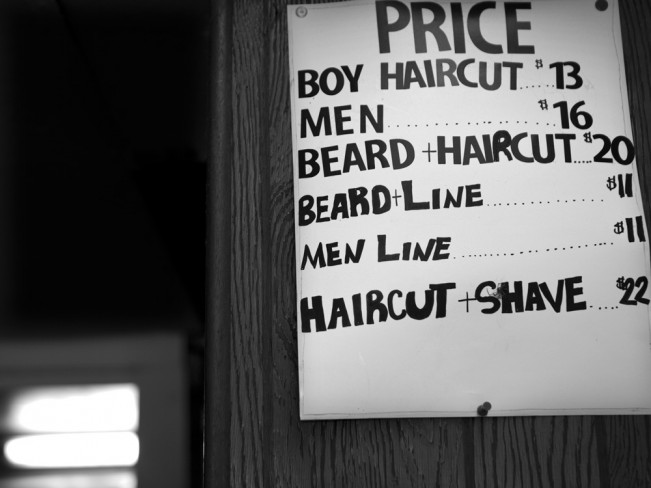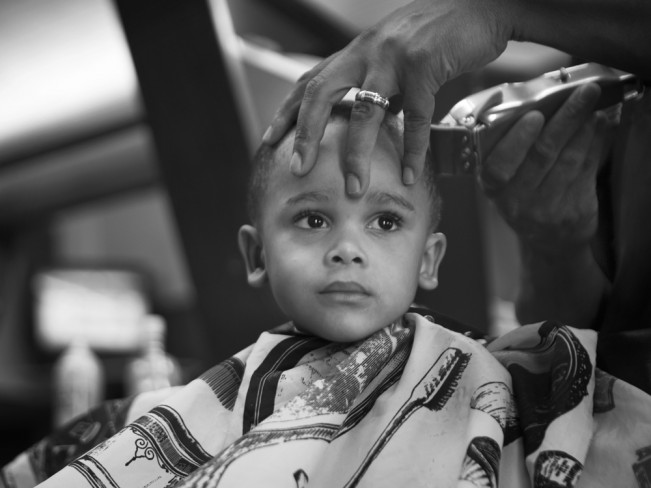Gloria Baker Feinstein: The Barbershop Project
 Gloria Baker Feinstein is along time friend and a talented and thoughtful photographer who has her priorities straight. Not only has she created a myriad of interesting projects, she started the non-profit organization, Change the Truth, that has been changing lives in Uganda. Be sure to visit the site and see the magic that is being created that all started with photography. Today, I am featuring her new project, The Barbershop Project.
Gloria Baker Feinstein is along time friend and a talented and thoughtful photographer who has her priorities straight. Not only has she created a myriad of interesting projects, she started the non-profit organization, Change the Truth, that has been changing lives in Uganda. Be sure to visit the site and see the magic that is being created that all started with photography. Today, I am featuring her new project, The Barbershop Project.
Gloria fine art and portrait photographer based in Kansas City. Her work has been included in exhibitions across the country and can be found in the collections of the High Museum, the Center for Creative Photography, the University of Kentucky Art Museum and the Nelson-Atkins Museum of Art, to name a few. Gloria’s photographs are published regularly in the Sun Magazine and New Letters Magazine. Her published book titles include: From the Heart: A Mosaic of Memories, Among the Ashes, Convergence and Kutuuka. Gloria is the founding director of the non-profit organization “Change the Truth” which provides assistance and opportunities to Ugandan children.
The Barbershop Project
Black-owned, old school barbershops are easy to find in Kansas City. Most are situated in the east side of town; that’s where these photographs were made.
During the 19th century, black-owned barbershops catered to a mostly prominent, white clientele. It was difficult for a black man to go to the black barber for a shave or haircut because he would be using the same instruments used on the white customers. This was unacceptable, even in the north. Slaves, “waiting men” or freed men ran the shops, which were competition for the white barbers. The black barbers owned the shops out of economic necessity. As long as the white men continued to patronize their barbershops, the barbers were able to provide for their families in middle-class fashion. The profession was extremely attractive because working inside far outshined working in the fields.
The black barbers owned the shops out of economic necessity. As long as the white men continued to patronize their barbershops, the barbers were able to provide for their families in middle-class fashion. The profession was extremely attractive because working inside far outshined working in the fields. After emancipation, black-owned barbershops opened up to black clientele. This was the beginning of the barbershop as a “haven” for black men. The intimacy of grooming encouraged both confidentiality and camaraderie, which made the barber shop an important gathering place for African American men. It was a place where a man could openly share his ideas and feelings, a place where a man who had no voice could have one.
After emancipation, black-owned barbershops opened up to black clientele. This was the beginning of the barbershop as a “haven” for black men. The intimacy of grooming encouraged both confidentiality and camaraderie, which made the barber shop an important gathering place for African American men. It was a place where a man could openly share his ideas and feelings, a place where a man who had no voice could have one. Black barbershops have been so significant in black history that authors Ralph Ellison, Toni Morrison and Richard Wright have all made reference to the “black man’s sanctuary.” Several customers I met told me they learned “how to be a man” by observing barbers and clientele in the shops they spent time in as young boys. To this day, the old-school barbershop remains more than just a place to get a haircut and a shave; it’s a place to feel secure and comfortable, a place to socialize, converse and debate, a place to share personal information and seek advice.
Black barbershops have been so significant in black history that authors Ralph Ellison, Toni Morrison and Richard Wright have all made reference to the “black man’s sanctuary.” Several customers I met told me they learned “how to be a man” by observing barbers and clientele in the shops they spent time in as young boys. To this day, the old-school barbershop remains more than just a place to get a haircut and a shave; it’s a place to feel secure and comfortable, a place to socialize, converse and debate, a place to share personal information and seek advice. The old school barbers insist on using straight edge razors, sharpening them on a long leather strap. They devote at least an hour to each customer, and they see their regulars every couple weeks. Hot topics of conversation include sports, women, politics, race and religion. And what is said in the barbershop stays in the barbershop. The older barbers, who call the younger ones merely “hair cutters” believe the true art of barbering will disappear with their generation. My plan is to travel to many cities and towns throughout the US to document these barbers and their shops before that happens.
The old school barbers insist on using straight edge razors, sharpening them on a long leather strap. They devote at least an hour to each customer, and they see their regulars every couple weeks. Hot topics of conversation include sports, women, politics, race and religion. And what is said in the barbershop stays in the barbershop. The older barbers, who call the younger ones merely “hair cutters” believe the true art of barbering will disappear with their generation. My plan is to travel to many cities and towns throughout the US to document these barbers and their shops before that happens.
Posts on Lenscratch may not be reproduced without the permission of the Lenscratch staff and the photographer.
Recommended
-
Kevin Cooley: In The Gardens of EatonJanuary 8th, 2026
-
William Karl Valentine: The Eaton FireJanuary 7th, 2026
-
Sean Stanley: Ashes of SummerJanuary 6th, 2026
-
Nathan Bolton in Conversation with Douglas BreaultJanuary 3rd, 2026
-
Andrew Lichtenstein: This Short Life: Photojournalism as Resistance and ConcernDecember 21st, 2025


































































